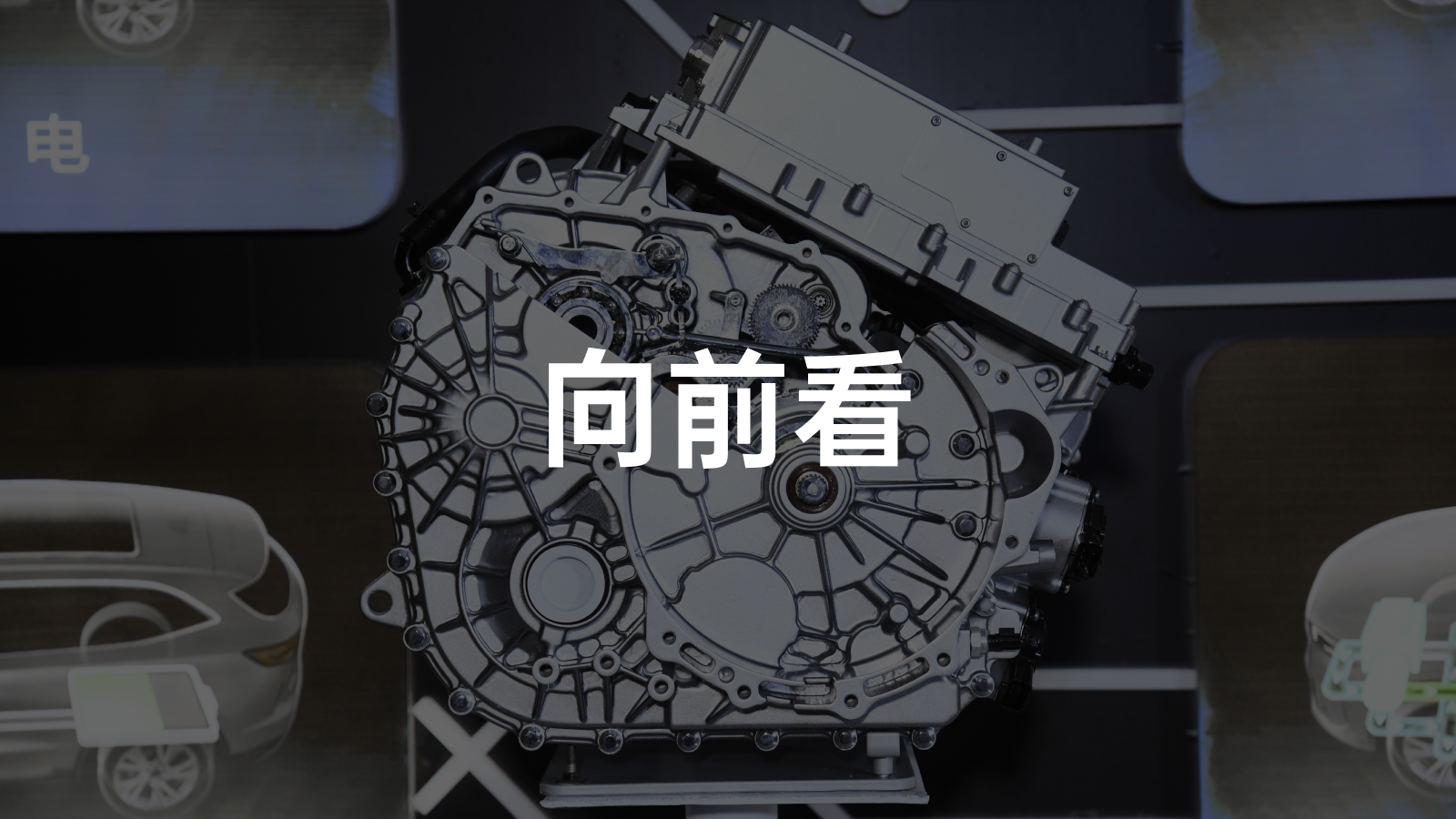Following the Lemon Platform and Coffee Intelligence, Great Wall Motors, which has been very active this year, held a “Lemon Hybrid DHT” hybrid technology conference on December 15, announcing its high-integration hybrid system with two power sources and three powertrains.
At a time when the industry is gradually shifting towards pure electric vehicles, Great Wall’s move seems a bit unconventional. When asked about this topic, a friend in the industry even thought Great Wall was “joining the army” in 1949.
Leaving aside the question of whether the hybrid route is politically correct, let’s take a look at the content of Great Wall’s conference.
A Dual Hybrid Strategy
Different from the HEV and PHEV choices of most manufacturers, Great Wall is taking an “I want it all” approach with the Lemon Hybrid DHT, which includes both HEV and PHEV.
As Great Wall put it, the Lemon Hybrid DHT system meets the needs of urban travel and high-speed travel by efficiently combining the hybrid engine and dual electric motors for optimal performance in all driving scenarios. Its characteristics can be highly summarized as “full-speed domain & full-scene, high efficiency & high performance.”
Between the lines, it is clear that Great Wall came prepared.
A Seven-in-One Hybrid Powertrain
The core of the Lemon Hybrid DHT system is its powertrain, which is highly integrated and includes:
- 1.5/1.5T hybrid-specific engine
- GM/TM dual electric motors
- Dual motor controller
- Integrated DCDC converter
- Fixed-axis gearbox
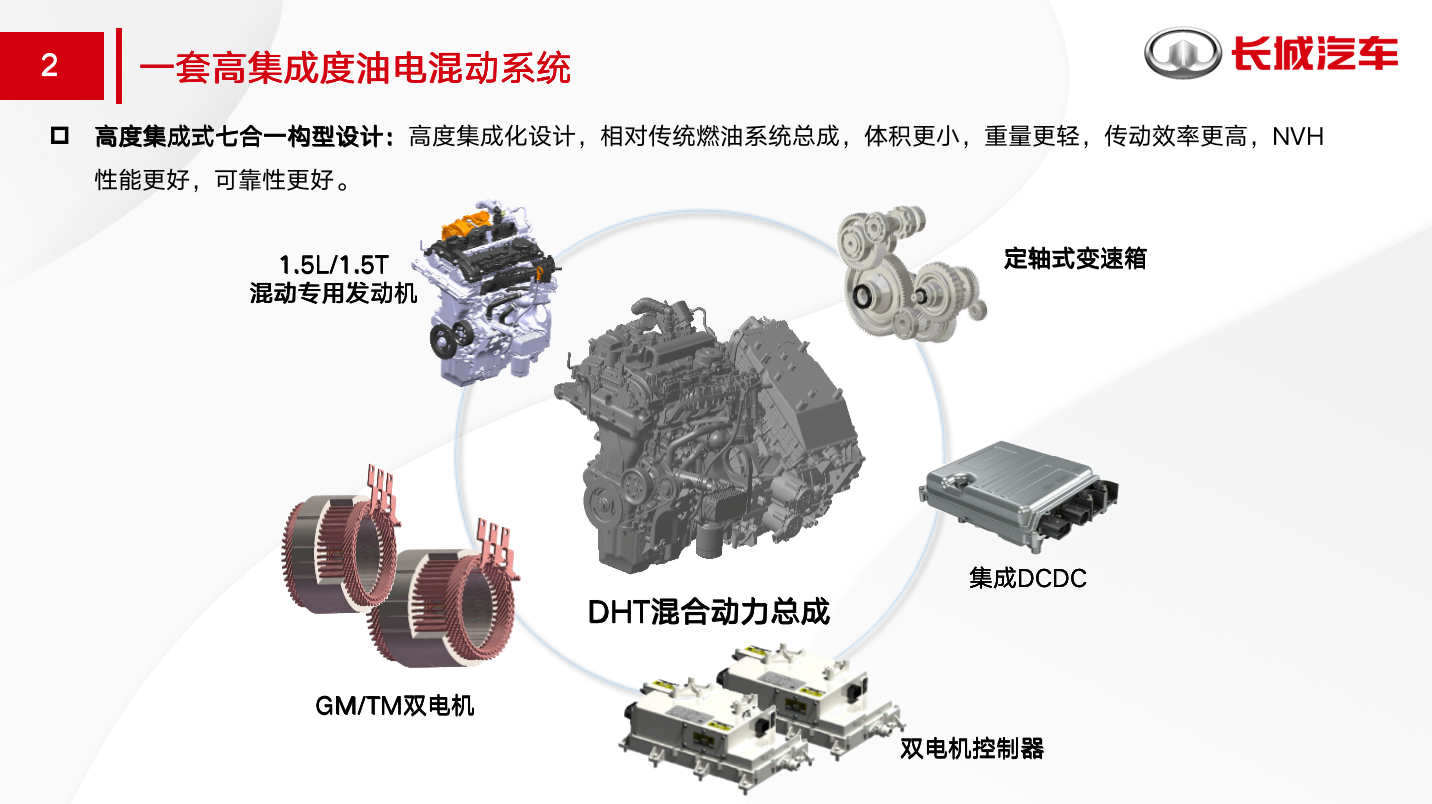
As you can see, this powertrain does not have the traditional transmission commonly found in PHEVs. Instead, it is equipped with a two-speed fixed-axis gearbox. This transmission mechanism has a maximum transmission efficiency of over 97%, which improves fuel efficiency and reduces the frequency of engine shifting. Moreover, with the assistance of the electric motors, shift changes can be made without power interruption, enhancing driving comfort.
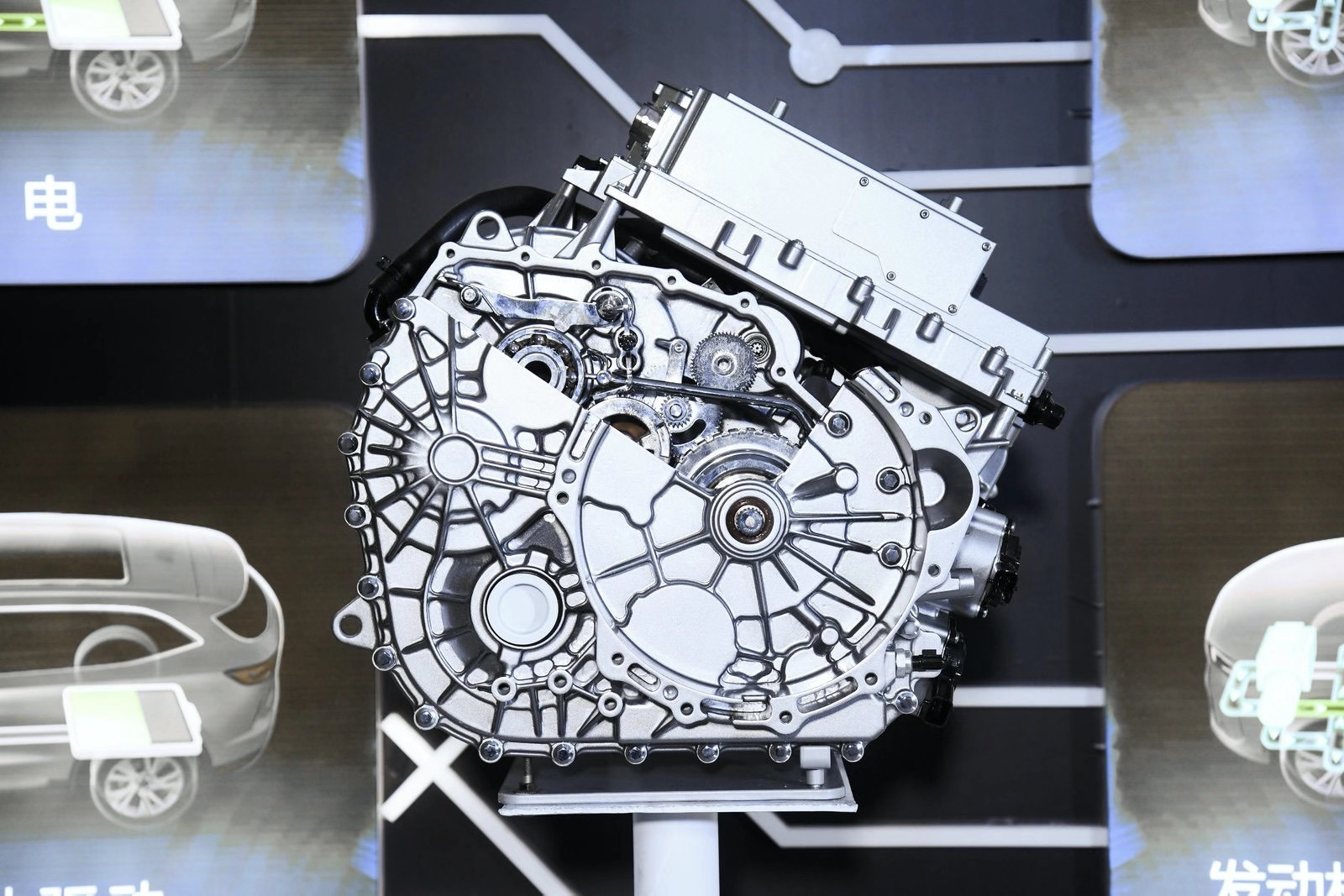
Great Wall’s introduction also mentioned that the motor stator adopts a low-harmonic winding structure, the rotor is a three-segment skewed pole design, and the gearbox uses a high gear overlap design. These measures reduce the noise in the powertrain system and improve vehicle NVH.
Does This System Look Familiar?
Another major highlight of this seven-in-one hybrid powertrain is its use of a dual electric motor topology.
In the DHT system, the vehicle is mostly driven directly by the TM motor. The electric power required for the operation of the TM motor can come from the vehicle’s power battery or from the GM motor generating electricity driven by the engine.
In addition, the engine in the DHT system can also directly drive the wheels. It can be parallel with the motor to provide more sufficient power output when high power is needed, or it can be directly driven alone to achieve the best fuel consumption in high-speed working conditions.
Does this system look familiar to you? If you have studied hybrids, you will easily find that it is similar to Honda’s i-MMD hybrid structure, which has a similar logic of low-speed pure electric, medium-speed range extension, and high-speed direct drive.
As for why this logic is used, interested readers can carefully read the PPT on the following page or I can summarize it in one sentence for everyone – This driving logic can make the vehicle’s energy efficiency optimal in different speeds and working conditions.
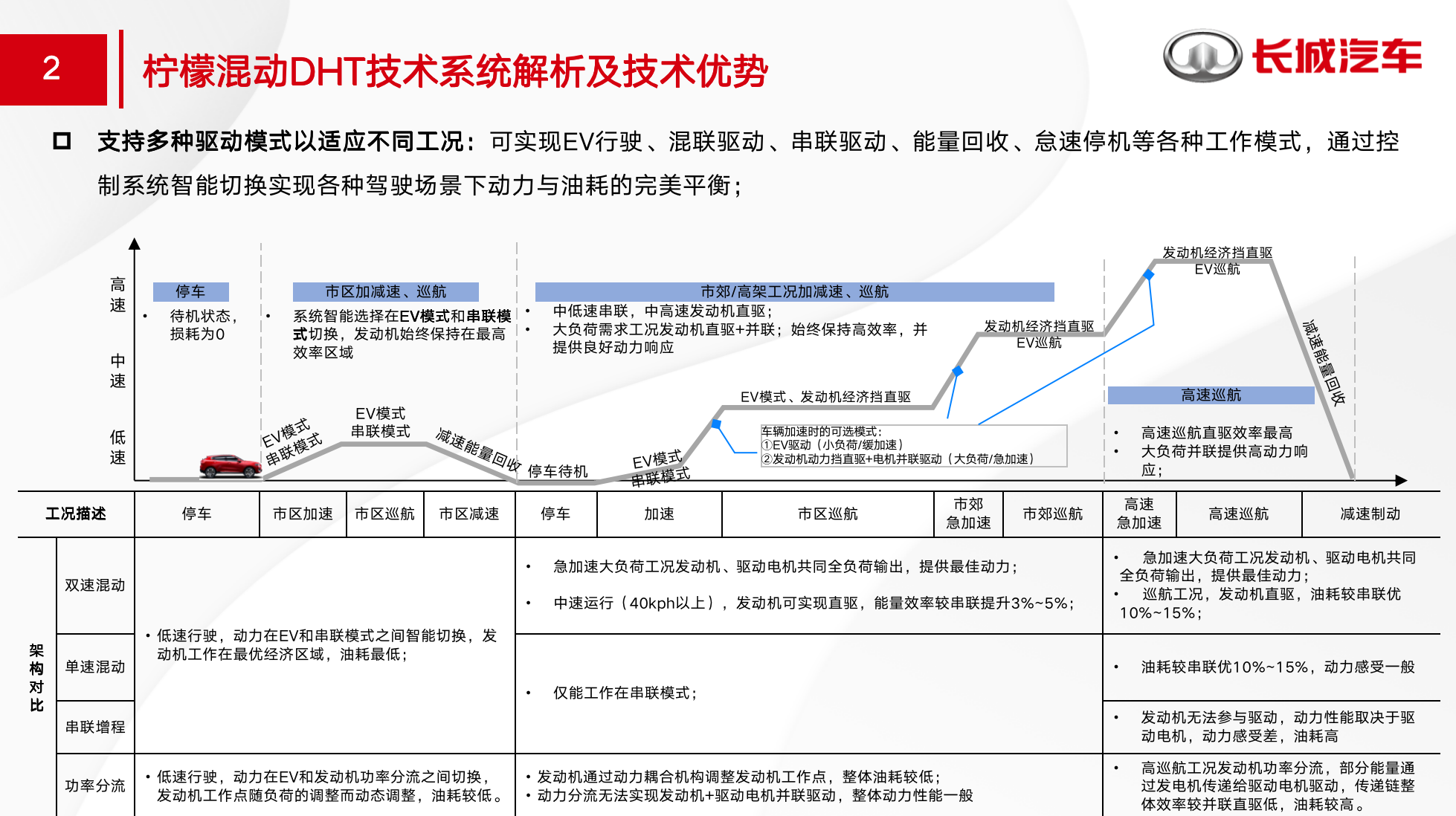
The difference between Great Wall Lemon Hybrid DHT and Honda i-MMD is that the engine and transmission structure of the two are different. Great Wall does not use the Atkinson cycle engine, and its engine energy consumption will be higher, but the power will be stronger.
According to the data published by Great Wall, the HEV power system of its B-class SUV has city fuel consumption of 5.0 L/100 km, highway fuel consumption of 6.5 L/100 km, and highway climbing fuel consumption of 12.5 L/100 km. The corresponding 0-100 km/h acceleration time is 7.5 seconds.
On the other hand, unlike i-MMD, Lemon Hybrid DHT has not only HEV but also PHEV.
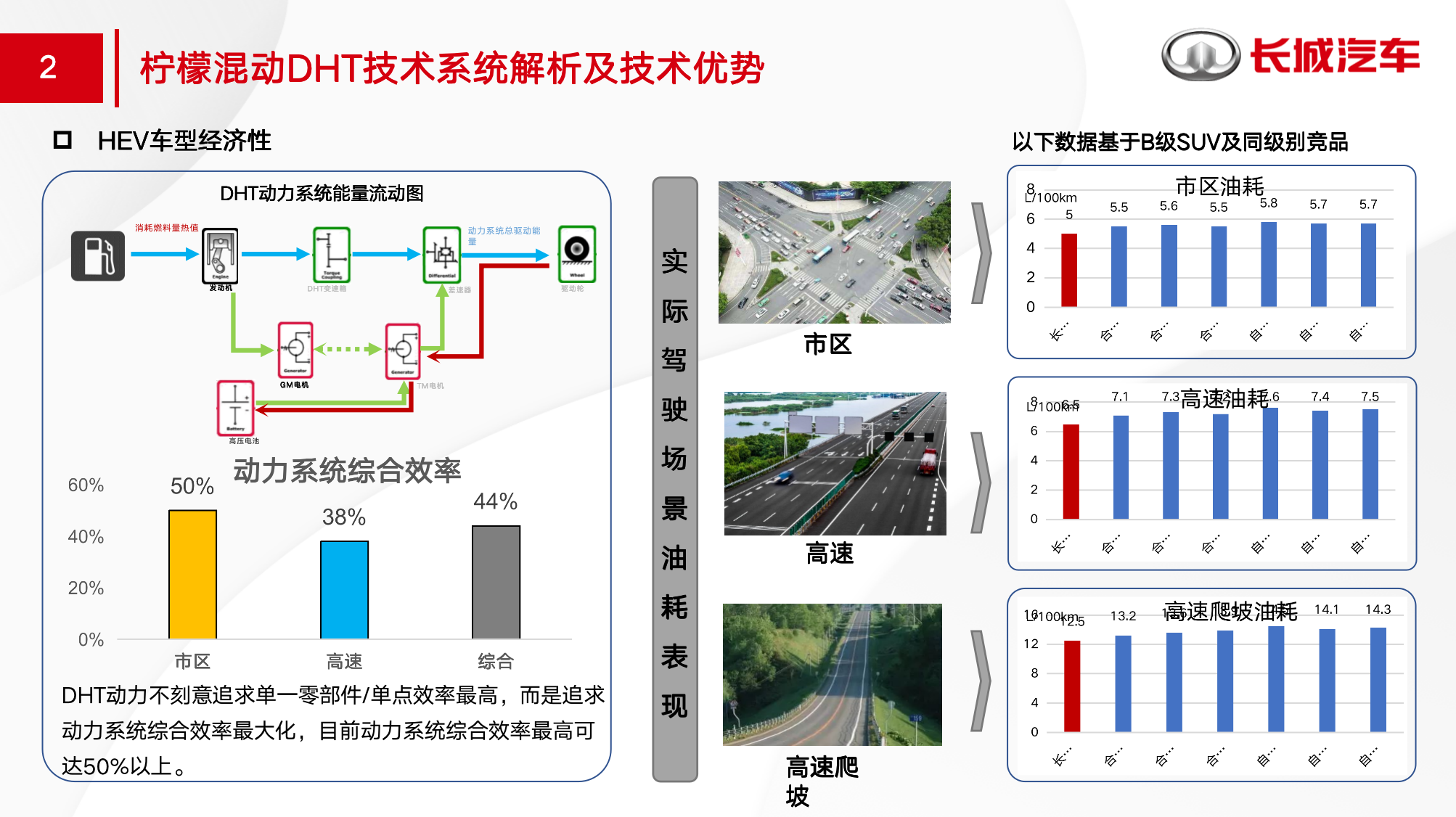
PHEV with 45-degree Battery, More than Just Large
The most intuitive feature of Lemon Hybrid PHEV is the large battery, among which the hybrid system for C-class cars uses a 45 kWh battery pack provided by CATL, which is the world’s largest PHEV battery pack. At this capacity, the pure electric range of the vehicle can reach 200 km.
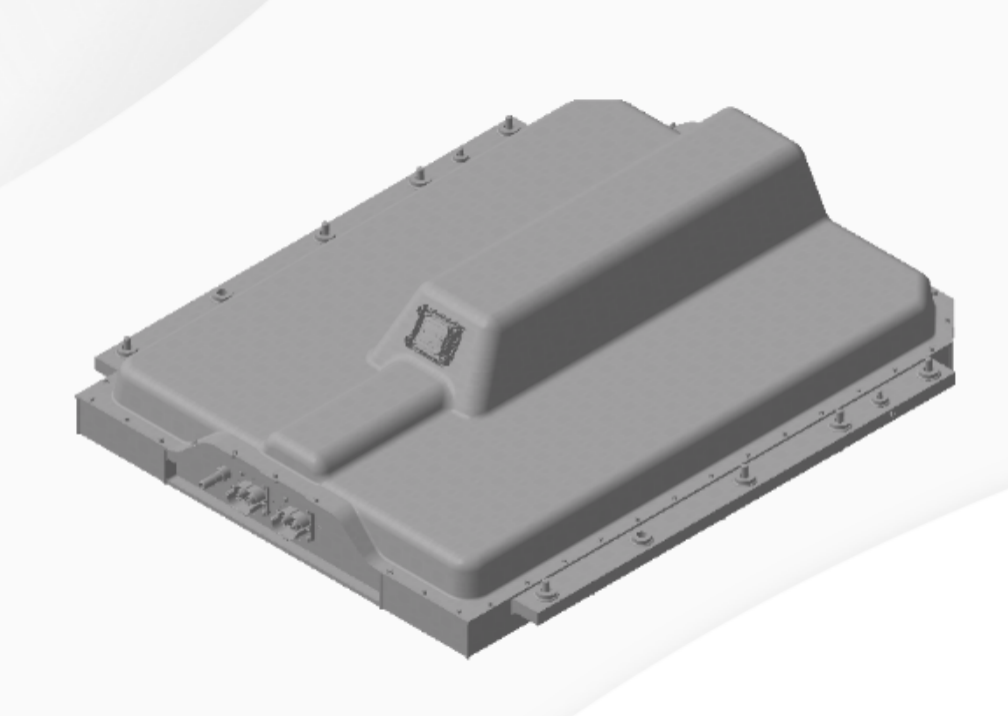 This PHEV battery pack not only has a large capacity, but also uses a de-modularized CTP structure, with an energy density greater than 160 Wh/kg and equipped with a water-cooling temperature control system. All of these are comparable to the current configuration of pure electric vehicles.
This PHEV battery pack not only has a large capacity, but also uses a de-modularized CTP structure, with an energy density greater than 160 Wh/kg and equipped with a water-cooling temperature control system. All of these are comparable to the current configuration of pure electric vehicles.
Moreover, the key point is that this battery can not only support the maximum 11 kW AC slow charging, but also support DC fast charging, and the time required for charging from 25% to 80% under DC fast charging is 26 minutes. This configuration seems like a “conventional operation”, but in the current reality where AC charging piles are rarely seen in public charging piles, it is a qualitative improvement for the charging replenishment experience of PHEV models.
In addition, the flagship PHEV model of the Lemon Hybrid is equipped with a P4 electric drive structure with a power of 135 kW and a torque of 233 N·m on the rear axle. This drive structure is also a high degree of integration of “motor + reducer + electric control” in the current industry, with a total system assembly of 75kg. This motor adopts a two-speed parallel shaft design, with first gear for high torque and second gear for high speed, providing better power performance and energy efficiency.
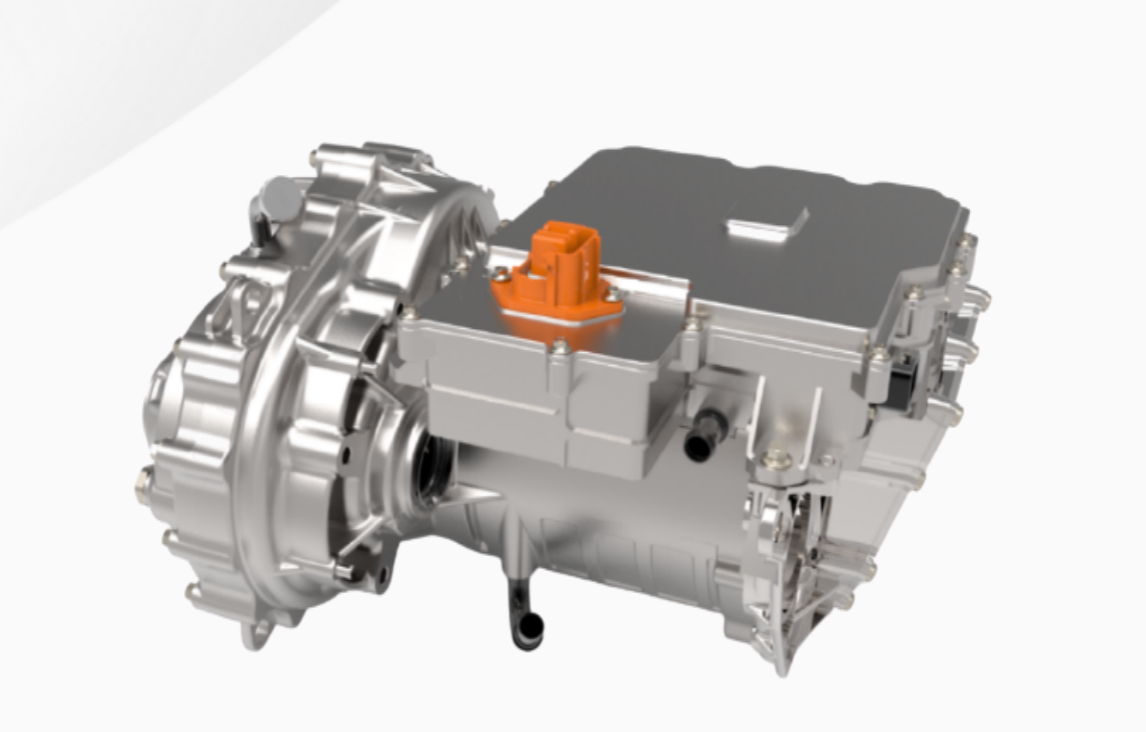
There is also a disconnect mechanism designed in this electric drive system, which can disconnect the motor from the axle when the P4 electric motor drive is not needed to reduce the drag loss. Great Wall officials said that the maximum loss can be reduced by 1.5 kW, which is approximately the difference between turning on and not turning on the air conditioner.
Why does Great Wall make the Lemon Hybrid?
This is a question with a broad scope. I think there’s no need to say much about the policy rhetoric regarding energy conservation and environmental protection. In my opinion, the release of the Lemon Hybrid by Great Wall has two important implications.
First: the future of Great Wall
Great Wall Motors is now a leading brand among domestic independent automakers, and with continued stable quality and highly competitive prices, Great Wall has established a solid position in the minds of the Chinese people.
“If we think we have succeeded, every successful past may shackle our future. If we can’t see the disruptive changes, we will be disrupted.” This is a sentence said by Wei Jianjun in the promotional video of the launch event.
Last year, Great Wall sold 1.06 million cars. As of November this year, Great Wall has sold more than 960,000 cars, and breaking through the one million mark again this year seems to be a foregone conclusion. However, behind the huge sales volume, there is also an issue that cannot be ignored.
Here are the sales of Great Wall Motors in the past 4 years:
- 2016: 1,074,471 units
- 2017: 1,070,161 units
- 2018: 1,053,039 units
- 2019: 1,060,298 units

Since surpassing one million annual sales in 2016, Great Wall’s sales volume has been floating around just over one million for the past four years with no significant growth. By November of last year, Great Wall had sold 950,000 cars, and this year, it is expected that Great Wall’s sales volume will be around 1.1 million.
However, despite the stagnant sales growth, Great Wall has actually been expanding its product line and deriving more sub-brands over the past few years. But more models have not brought more sales. To some extent, this is already a decline.
“What about the future? In my view, it’s a toss-up,” said Wei Jianjun in a promotional video for the press conference. Great Wall needs to find a breakthrough now, and the Lemon Hybrid DHT is an important attempt.
Looking back at the Lemon Hybrid DHT’s three sets of powertrains, it is not difficult to see that it is a system with a very wide coverage.
- The powertrain mainly used for A-class models is composed of a 1.5-liter engine and a DHT 100 (a high-integration hybrid gearbox) with a total power of 140 kW – 170 kW, capable of achieving both HEV and PHEV power;
- The powertrain mainly used for B-class models is composed of a 1.5T engine and a DHT 130 (a high-integration hybrid gearbox) with a total power of 180 kW – 240 kW, capable of achieving both HEV and PHEV power;
- The powertrain mainly used for C-class models is composed of a 1.5T engine, a DHT 130 (a high-integration hybrid gearbox), and a P4 motor (135 kW), and only available in PHEV form, with a total power of 320 kW.
According to Great Wall’s information, the comprehensive efficiency of these three powertrains can reach up to 50%, and the key to this is the seven-in-one hybrid system mentioned earlier. Except for the C-class car set, which has an additional P4 motor, the main difference between the other HEV/PHEV sets is the battery.
Under this combination, almost all Great Wall models can flexibly match the corresponding hybrid powertrains based on the market positioning and demand, making it possible to produce PHEV models that meet the range threshold in limited cities and provide a cost-effective HEV solution for A-class and B-class models with the widest coverage that are suitable for cities without road restrictions.
For Great Wall, which is seeking growth, such a widely covered Lemon Hybrid DHT is undoubtedly a good bet.
Second: consumer demand for hybridsColleague 63 once said something that I fully agree with: “A good PHEV must first be a good HEV.” What does this mean? I think we can analyze the representative hybrid products of the successful HEVs in today’s market – the ones made by Japanese carmakers Toyota and Honda.
In the Chinese market, Toyota’s HEVs are not classified as new energy vehicles due to their pure electric range not meeting standards, and they are sold purely as fuel-powered cars. However, even without the tax exemption, new energy subsidies, and green license plates reserved for new energy vehicles, Toyota’s hybrid models, which are more expensive than their standard counterparts, have still achieved good market performance.
This is because, despite the higher price, they offer consumers a better driving experience with perceptibly lower fuel consumption, and they do not have the limitations of needing to be charged, offering the same convenience as ordinary cars. These are all meaningful improvements for consumers.
In comparison, most PHEVs in China are significantly more expensive than their fuel-powered counterparts due to the additional large motors and batteries. However, the comprehensive driving experience that comes with the higher price is often unsatisfactory. Even though PHEV models with the large motor perform well in electric mode, their “big batteries” usually only achieve a pure electric range of around 70 km according to NEDC. Additionally, most of these models do not support public DC fast charging stations, making it inconvenient for users who do not have private charging facilities.
Under these circumstances, driving with gasoline assistance has become the norm for most PHEVs. However, most of these PHEVs still have traditional transmissions that cause jerky driving and sudden power cuts when driving with gasoline assistance, and their fuel consumption is not lower than that of ordinary cars. They are too “specialized”, and the difference between their electric and non-electric states is too “split-personality”. With these downsides, PHEV models with unremarkable fuel-powered powertrains are naturally unpopular in the market, even with so many policy supports.
Pursuing momentary satisfaction from the electric mode is insufficient. A more comprehensive approach, such as that of the Japanese HEVs, better meets consumers’ demands. It seems like Great Wall Motors has realized this issue, so apart from the powertrains used in their C-class cars, all other models have not adopted high-power electric motors, and instead, all powertrains feature specialized GM generators that prioritize smoothness and energy efficiency. For high-power PHEVs, Great Wall Motors has prepared large batteries, with NEDC ranges of up to 170 km for two-wheel-drive models and 200 km for four-wheel-drive flagship models.

In addition, as mentioned earlier, all these models are based on the DHT seven-in-one powertrain, a hybrid powertrain that emphasizes smoothness and energy efficiency. In my opinion, this is a wise choice that is also aligned with consumer demands.
ConclusionDuring the launch event, Great Wall stated that the Lemon Hybrid DHT was completely independently designed and developed, with full independent intellectual property rights and a total of 199 patents, including 80 core patents, after a 23-month period of hard work.
This means that the DHT hybrid project started in 2018, which is a bit late compared to competitors, but for Great Wall Motors, as long as the revolution occurs before the crisis arrives, it is not considered late.
Also in 2018, Great Wall Motors’ first hybrid model, the WEY P8, was launched, while in the same year, BYD Tang second-generation was released. Both using the PHEV architecture, WEY P8 obviously had insufficient performance as a latercomer, and its market performance was unsatisfactory.
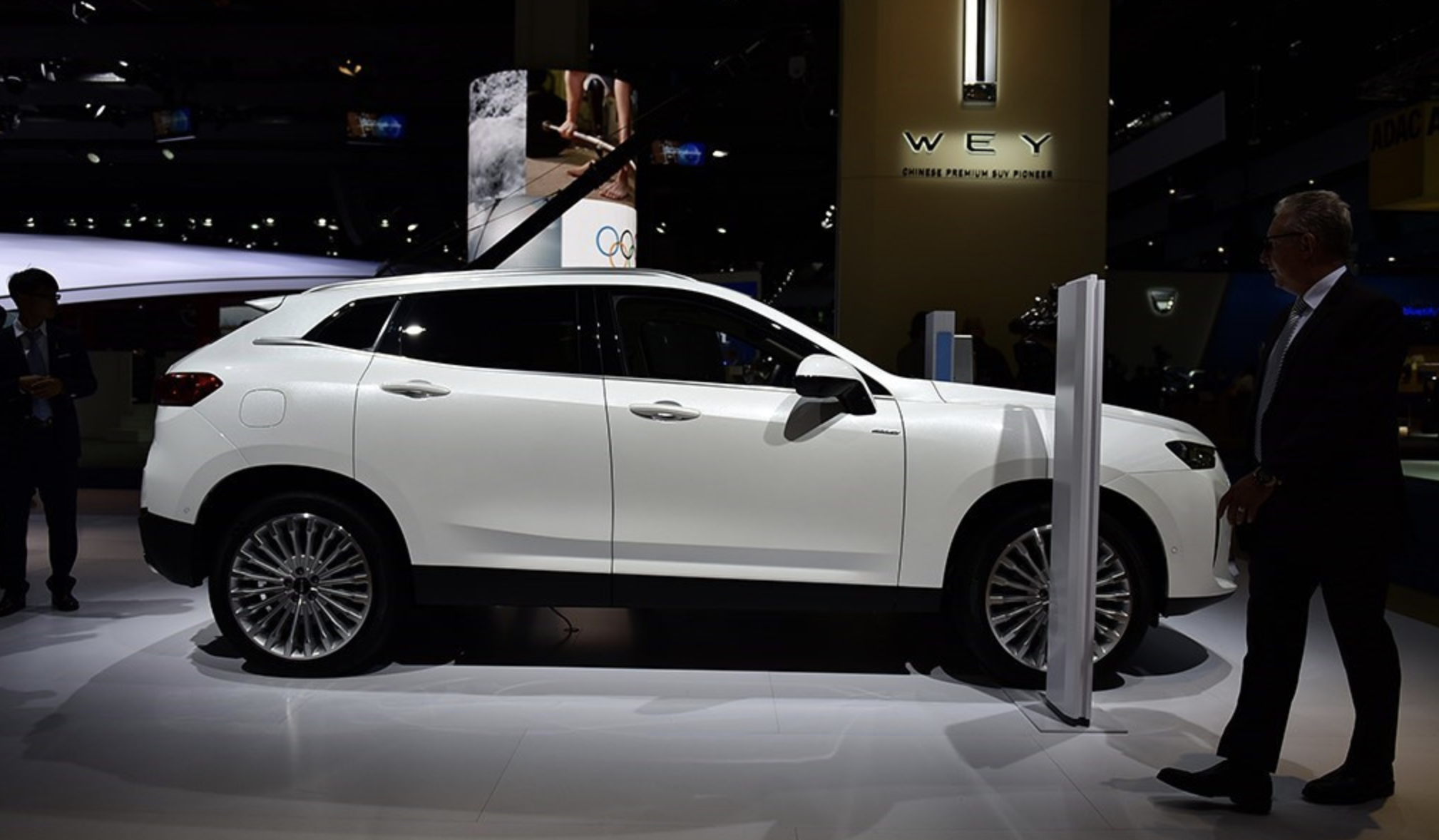
However, perhaps this failed attempt made Great Wall realize what kind of hybrid vehicles consumers really need. Lemon Hybrid DHT obviously demonstrates this user-centric thinking. As a latecomer, avoiding competitors’ patents with homogenized technology is also a challenge, and the process of technological research and development is bound to be difficult. Fortunately, all of these are now “in hindsight.”
So, looking ahead, what are some challenges?
First is the price issue. The model equipped with DHT hybrid is much more expensive than the regular version. Using the Honda Accord as a reference, the current starting price of the hybrid entry-level model is about 20,000 yuan more expensive than the regular entry-level model, and the starting price of the regular version is 180,000 yuan, a difference of 11%.
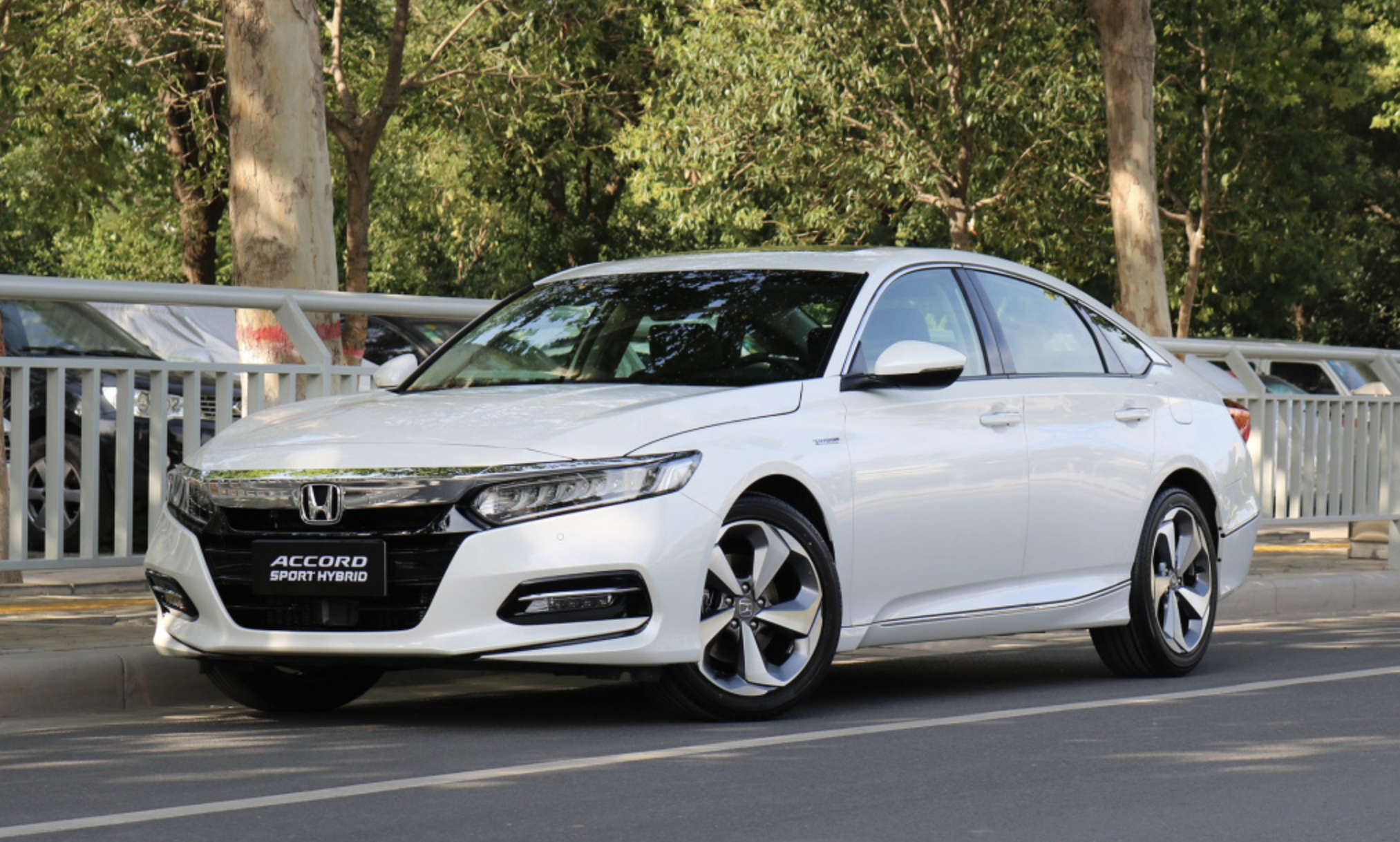
The current starting price for the third-generation H6 automatic transmission entry-level model is 106,000 yuan. If we use the same ratio of added value as the Accord hybrid, the price of the H6 DHT version should be around 117,600 yuan, which I think is a reasonable price. However, as a newcomer in the new energy field, it remains to be seen whether Great Wall will have the ability to control costs to such a level. Additionally, the proportion of price increase after installing a large battery for PHEV models is also key to whether it is accepted by consumers.
On the other hand, there is also the issue of brand recognition. Although Great Wall SUVs have been recognized by consumers, it will take time for consumers to recognize Great Wall’s new energy products; that is, Great Wall’s new energy products must be truly good and recognized by consumers, and this is not an easy task.And during the two years of Great Wall’s quiet efforts, its competitors have also been active. BYD’s DM 4.0 hybrid technology, which was released this year, uses an Atkinson cycle engine with a thermal efficiency of 43%. The corresponding DM-i models will focus on fuel economy. The latest Qin PLUS approved by the Ministry of Industry and Information Technology has a fuel consumption of only 3.8L/100 km. BYD’s positioning for this hybrid system is also “seizing the market of fuel cars”.
Although the Lemon Hybrid DHT is a good start, Great Wall has only taken the first step in its challenging path of self-breakthroughs.
This article is a translation by ChatGPT of a Chinese report from 42HOW. If you have any questions about it, please email bd@42how.com.
